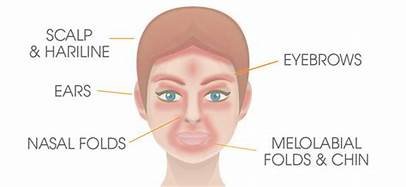
Fabric of Hair Investigates: Scalp Issues, Seborrheic Dermatitis🧐
What is seborrheic dermatitis?
Seborrheic dermatitis is an inflammation of the upper layers of skin, characterized by red, itchy skin that sheds scales. Seborrheic dermatitis may be a hereditary condition. It is often aggravated by hormonal changes and cold weather conditions.
Seborrheic dermatitis is most common during middle age. When seborrheic dermatitis happens at this age, the condition is usually more intermittent and called dandruff. People with oily skin or hair are also more at risk for developing seborrheic dermatitis.
What are the symptoms of seborrheic dermatitis?
The following are some of the other symptoms associated with seborrheic dermatitis. However, each person may experience symptoms differently.
Symptoms may include:
Itching scalp,
Dry or greasy scales on the scalp,
A yellow or red scaly rash along the hairline, behind the ears, in the ear canal, on the eyebrows, around the nose, in creases on the arms, legs, or groin, and/or on the chest.
How is seborrheic dermatitis diagnosed?
A complete medical history and physical exam helps the healthcare provider in diagnosing seborrheic dermatitis.
The condition responds to treatment, it may happen again. Treatment depends on the inflammation's location. It is usually effective in relieving symptoms.Treatments may include:
Anti-inflammatory creams or lotions, such as corticosteroids or calcineurin inhibitors
Antifungal topicals
Over-the-counter dandruff shampoos
Medicated shampoo for adults, as prescribed by your healthcare provider
Natural Remedies
Traditional treatments for Seborrheic Dermatitis mainly consist of harsh dandruff shampoos and dangerous topical steroids. The problem with these conventional treatments is that they're usually ineffective, unsafe, only treat one symptom, have severe side effects, and the results don't last.
A slightly better solution would be one of the few natural home remedies that seem to get results...like apple cider vinegar, raw organic honey and aloe vera.
Essential Oils
The best way to get quick and lasting relief from Seborrheic Dermatitis is with certain essential oils. You may have read that Tea Tree oil is effective against Seborrheic Dermatitis. Well that's a fact, Tea Tree oil works great. But if you stop there, you're missing out on a whole array of different oils that can greatly amplify that effectiveness.
For example Neem oil, Cedarwood oil, Patchouli oil, Lavender oil, Rosemary oil, Oregano oil, Peppermint oil, and Eucalyptus oil all have proven properties that can quickly relieve Seborrheic Dermatitis symptoms. In fact Oregano oil is one of the most powerful antifungals (kills yeast) available, and it's all natural!
Although seborrheic dermatitis is itchy and uncomfortable, it does not harm your health. The condition can be managed with treatment. Itchy skin and white flakes on your black shirts shouldn’t be a normal part of your lifestyle.